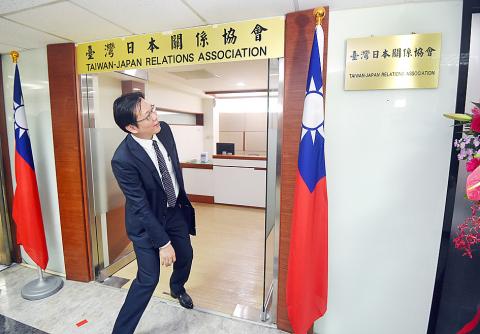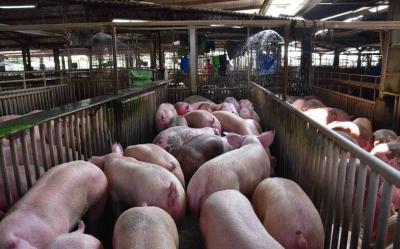Renaming Japan’s representative office in Taipei as the Taiwan-Japan Relations Association would help lessen misunderstandings and reflect Taiwan’s burgeoning relationship with Japan, association president Chiou I-jen (邱義仁) said yesterday at the official unveiling of the association’s new doorplate in Taipei.
“While people were clear about what we were concerned with when the office was first established, as time has gone by, many no longer have a clue,” Chiou said, recalling how he once received a telephone call asking him to resolve an issue in Hawaii.
“Finally” changing the name of the non-governmental agency, formerly known as the Association of East Asian Relations, Taiwan, after almost 45 years lends clarity to the association’s mission, he said.

Photo: Liao Chen-huei, Taipei Times
The association was established in 1972 to handle relations with Japan after diplomatic ties were broken off, with its Tokyo branch — the Taipei Economic and Cultural Representative Office in Japan — also serving as Taiwan’s de facto embassy in the nation.
While officially a civic organization under government contract, most employees simultaneously hold positions at the Ministry of Foreign Affairs.
The name change follows a similar change on the part of its Japanese counterpart earlier this year, which changed its name from Interchange Association, Japan to the Japan-Taiwan Exchange Association.
“Before we changed our name, a lot of people were not clear about our mission — we even had people calling and asking us about marriage matches,” Japan-Taiwan Exchange Association Representative Mikio Numata said, adding that the renaming is a “historic step,” as its name now conforms with reality.
“The name changes not only help the outside world understand the substantial content of both associations’ work — it also verifies the continued positive development of Taiwan-Japanese relations,” Minister of Foreign Affairs David Lee (李大維) said.
Relations have “never been better or more intimate,” he said, citing record-high bilateral trade and tourism.
Any discussion of renaming the Coordination Council for North American Affairs — which handles relations with the US — would have to wait until US President Donald Trump fills key Department of State vacancies, he said.
The ministry’s Japanese Political Affairs director, Fu Kuo-hua (傅國華), said the name changes primarily reflected a shift in Taiwan’s stance.
Japan had proposed using “Taiwan-Japan” to name the associations when official diplomatic ties were first broken off, but the proposal was rejected by Chiang Kai-shek’s (蔣介石) administration, which wanted to use “Chinese-Japanese,” he said.
China yesterday called the name change a “conspiracy” and urged Japan not to send “false signals” to Taiwan and the international community.
“We strongly object to this attempt to upgrade Japanese-Taiwanese relations,” Chinese Ministry of Foreign Affairs spokeswoman Hua Chunying (華春瑩) said. “We urge the Japanese government to scrupulously abide by the principles of the Japan-China Joint Communique, as well as all the promises which Japan has made to China to the present, including holding firm to the ‘one China’ principle.”
“The Japanese government should take concrete action to correct wrong methods and should not send false signals to Taiwan’s government and the international community, creating new interference for Sino-Japanese relations,” she said. “We also want to tell the Taiwanese government that any attempt to create ‘two Chinas’ or ‘one China, one Taiwan’ is doomed to failure.”
Additional reporting by CNA

The combined effect of the monsoon, the outer rim of Typhoon Fengshen and a low-pressure system is expected to bring significant rainfall this week to various parts of the nation, the Central Weather Administration (CWA) said. The heaviest rain is expected to occur today and tomorrow, with torrential rain expected in Keelung’s north coast, Yilan and the mountainous regions of Taipei and New Taipei City, the CWA said. Rivers could rise rapidly, and residents should stay away from riverbanks and avoid going to the mountains or engaging in water activities, it said. Scattered showers are expected today in central and

COOPERATION: Taiwan is aligning closely with US strategic objectives on various matters, including China’s rare earths restrictions, the Ministry of Foreign Affairs said Taiwan could deal with China’s tightened export controls on rare earth metals by turning to “urban mining,” a researcher said yesterday. Rare earth metals, which are used in semiconductors and other electronic components, could be recovered from industrial or electronic waste to reduce reliance on imports, National Cheng Kung University Department of Resources Engineering professor Lee Cheng-han (李政翰) said. Despite their name, rare earth elements are not actually rare — their abundance in the Earth’s crust is relatively high, but they are dispersed, making extraction and refining energy-intensive and environmentally damaging, he said, adding that many countries have opted to

SUPPLY CHAIN: Taiwan’s advantages in the drone industry include rapid production capacity that is independent of Chinese-made parts, the economic ministry said The Executive Yuan yesterday approved plans to invest NT$44.2 billion (US$1.44 billion) into domestic production of uncrewed aerial vehicles over the next six years, bringing Taiwan’s output value to more than NT$40 billion by 2030 and making the nation Asia’s democratic hub for the drone supply chain. The proposed budget has NT$33.8 billion in new allocations and NT$10.43 billion in existing funds, the Ministry of Economic Affairs said. Under the new development program, the public sector would purchase nearly 100,000 drones, of which 50,898 would be for civil and government use, while 48,750 would be for national defense, it said. The Ministry of

African swine fever was confirmed at a pig farm in Taichung, the Ministry of Agriculture said today, prompting a five-day nationwide ban on transporting and slaughtering pigs, and marking the loss of Taiwan’s status as the only Asian nation free of all three major swine diseases. The ministry held a news conference today confirming that the virus was detected at a farm in Wuci District (梧棲) yesterday evening. Authorities preemptively culled 195 pigs at the farm at about 3am and disinfected the entire site to prevent the disease from spreading, the ministry said. Authorities also set up a 3km-radius control zone